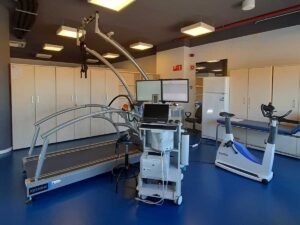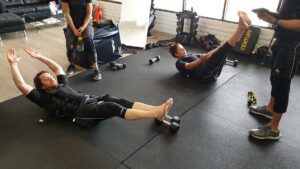Electrostimulation in skeletal muscle is a new therapeutic strategy with promising effects in terms of treatment with patients with chronic heart failure. When the capacity of the left ventricle is reduced in patients with heart failure, a series of changes occur that lead to a loss of skeletal muscle and abnormalities resulting from muscle metabolism. Therefore, maintaining muscle mass in patients with heart failure is a good strategy to improve left ventricular dysfunction. Therefore, physical training could be a tool to break this vicious circle due to its beneficial effects and since some patients with heart failure are not in a position to perform traditional physical training, the use of electrostimulation can be an attractive and elegant alternative to perform physical training. Because of this, the objective of this study was to evaluate the beneficial effects of different electrostimulation strategies on exercise capacity, oxygen consumption and left ventricular function in patients with heart failure.
60 people underwent the electrostimulation program in this study. 34 of the 60 people with stable symptoms of heart failure. Of the 34, 22 people received Whole-body electrostimulation and 12 received electrostimulation in the buttocks, quads, and twins. The remaining 26 were established in the control group who also received Whole-body electrostimulation to compare the effects of WB EMS in people with and without heart failure. Regarding the electrostimulation protocol, a frequency of 80 Hz was used with a work cycle of 4 seconds of electrical impulse and 4 seconds of rest. Regarding the intensity threshold, it focused on the client’s perception because the muscular contraction performed by electrostimulation depends on the body composition and the resistance of the skin. The goal of the training was based on sufficient muscle activation but without reaching the pain threshold. The training was carried out for 10 weeks, two sessions a week and each session was 20 minutes with electrostimulation using a WB-EMS training system.
Once all the electrostimulation sessions were over, the 60 subjects were examined immediately one week later. The test was performed with spirometry on a treadmill. All the subjects performed the test according to their personal abilities, they started with 10 W with an increase of 10 W every 2 min or on the other hand, they started with 25 W increasing 25 W every 2 min. The test ended when the subject had difficulty breathing, muscle exhaustion, severe arrhythmia, or dizziness. This test was performed before and after having performed all the electrostimulation sessions.
When analyzing the results in all groups, there was an increase in oxygen consumption and in the whole body electrostimulation group with patients with chronic heart failure, the capacity of the left ventricle improved compared to the group that used electrostimulation in quadriceps. gluteus and gastrocnemius.
Therefore, analyzing the results, we can conclude that with complete body electrostimulation, oxygen consumption and left ventricular capacity are significantly improved in patients with chronic heart failure.
On the other hand, it should be noted that the methodology regarding the tests and measurements carried out in this study are very good, therefore, we can support the results obtained. However, due to the lack of specification of the training system, we can think that a classical methodology of training with Whole-body electrostimulation has been used.
This being the case, we consider it appropriate to emphasize that training with functional exercises and undulating periodization with Whole-body electrostimulation is more effective than the classical methodology for training with full-body electrostimulation [2]. Therefore, it would be very interesting to see what effects can be obtained by sequencing the electrical charges over time and performing exercises that are not exclusively based on static and basic positions during the electrical impulse.
Informative note
This study does not specify whether study participants underwent prior adaptation to WB-EMS. Therefore, from Wiemspro we advise that before applying a WB-EMS training protocol, an adaptation period must be passed with a frequency below 50 Hz without reaching electrostimulation intensities that can cause high exhaustion for at least 6 -8 sessions.
Bibliografía
- Van Buuren, Frank Mellwig, Klaus Peter Prinz, Christian Körber, Britta Fründ, Andreas Fritzsche, Dirk Faber, Lothar Kottmann, Tanja Bogunovic, Nicola Dahm, Johannes Horstkotte, Dieter. (2013). Electrical myostimulation improves left ventricular function and peak oxygen consumption in patients with chronic heart failure: Results from the exEMS study comparing different stimulation strategies. Clinical Research in Cardiology, 102, 523-534.
- Amaro-Gahete, Francisco J. De-la-O, Alejandro Sanchez-Delgado, Guillermo Robles-Gonzalez, Lidia Jurado-Fasoli, Lucas Ruiz, Jonatan R. Gutiérrez, Angel. (2018). Functional exercise training and undulating periodization enhances the effect of whole-body electromyostimulation training on running performance. Frontiers in Physiology, 9, 1-12.







